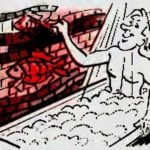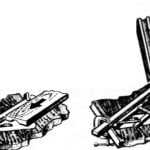It is not in vain that they say, “The bath steams, the bath heats, the bath fixes everything.” Unfortunately, for many, the meaning of this folk wisdom becomes apparent too late, when the list of illnesses begins to approach a critical point. And yet, it seems so simple, as the old folks taught: a hot bath, a birch broom, and no ailment will take hold! The preventive properties of the bath have been known for centuries, so those who care about their health constantly “befriend” it. It’s not uncommon today to have private baths and saunas in summer cottages, garden plots, and country communities. Saunas are also built in enterprises, sports complexes, complemented by relaxation rooms, pools, gymnasiums, and other attributes of health improvement.
The construction of the bath or sauna building itself will not pose a particular challenge for people who know how to handle an axe and saw, especially for readers of “Modelist-Konstruktor.” In this case, one can use “grandfather’s” methods, traditional, time-tested ways, or more modern technologies (see, for example, “M-K” No. 10 for 1991). However, every builder sooner or later faces the main question—the construction of the stove—since it is absolutely clear: without a good stove, there will be no hot bath.

1 — firebox, 2 — flame arrester, 3 — water tank, 4 — heat exchanger.
In such a situation, I thought a lot about this question, flipped through a lot of literature, saw a lot in nature, and experienced a lot myself, taking the heat of these baths. Strangely enough, most designs didn’t appeal to me because the steam in them is “raw.” And yet, the most important thing in a sauna or bath is the temperature and “dry” steam.
So, how to build a stove in a bath on your own plot? Firstly, I believe that using electric heating is not economically viable. Secondly, stove designs with side water tanks do not allow obtaining steam with the necessary “dryness” since the water boils much earlier than the steam room volume heats up—creating that same “raw” steam.

1 — wall (steel, 0.8x500x600 mm, 2 pcs.), 2 — side sheet (steel, 0.8x350x500 mm, 2 pcs.), 3 — nipple (3/4″ length 40 mm, 3 pcs.), 4 — top sheet (steel, 0.8x350x600 mm), 5 — cover (steel, 0.8x200x350 mm), 6 — hinge (steel, 0.8x30x60 mm, 2 pcs.), 7 — double hinge (2 pcs.), 8 — bottom sheet (steel, 0.8x350x600 mm).
After analyzing all of this, considering my capabilities, I acted as follows. I made a simple “bourgeois” stove with a heat exchanger inside the firebox for heating water and an open pocket above the firebox for stones. The placement of the “stone pocket” is dictated by safety considerations—by directing the steam upward, you can get severe burns, so in my version, it goes up.

1 — side wall (steel, 2x146x246 mm, 2 pcs.), 2 — rear wall (steel, 2x150x150 mm), 3 — plank (steel, 2x10x120 mm, 4 pcs.), 4 — damper (steel, 2x145x300 mm), 5 — pipe (100×2.5 mm, length 30 mm), 6 — pipe (105×2.5 mm, length 30 mm), 7 — front wall (steel, 2x74x150 mm, 2 pcs.), 8 — sheet with Ø95 mm holes (steel 2x146x246 mm, 2 pcs.).
The stove itself is made of ordinary sheet steel with a thickness of 4…5 mm. I do not recommend using “stainless steel” for such purposes due to its low thermal conductivity. However, it is the most suitable material for the tank with hot water and the heat exchanger.

1 — pipe (50×2.5 mm, length 250 mm), 2 — pipe (50×2.5 mm, length 447.5 mm, 2 pcs.), 3 — nipple (3/4” length 50 mm, 2 pcs.), 4 — washer (50×2.5 mm, 2 pcs.).
The tank is made separately from the stove, so it can be placed in any room: in the anteroom, in the washing area, or even on the external side of the bath—depending on the area and the convenience of water supply. The tank is mounted on the wall, its lower level should be at least 500 mm higher than the stove’s heat exchanger. The tank and heat exchanger nipples are connected by a rubber hose with clamps. Ensure that the hose does not sag and rises evenly from the stove to the tank. In principle, the hose can be replaced with pipes, depending on your capabilities.

1 — sheet with a hole for the pipe (steel 4x342x592 mm), 2 — pipe (steel 100×2 mm, length 300 mm), 3 — heat exchanger, 4 — rear sheet with holes for heat exchanger nipples (steel, 4x350x600 mm), 5 — side sheet (steel, 4x592x592 mm, 2 pcs.), 6 — bottom sheet (steel, 4x342x592 mm), 7 — support (pipe 20×2, length 147 mm, 2 pcs.), 8 — heel (0 30×3 mm, 4 pcs.), 9 — support (pipe 20×2 mm, length 47 mm, 2 pcs.), 10 — air supply side panel (steel, 4x100x400 mm, 2 pcs.), 11 — rear air supply panel (steel 4x100x342 mm), 12 — bottom air supply panel (steel, 4x342x392 mm), 13 — screen wall (steel 4x200x450 mm, 2 pcs.), 14 — screen bottom and visor (steel, 4x200x342 mm, 2 pcs.), 15 — sides of the front panel (steel, 4x50x400 mm, 2 pcs.), 16 — firebox door (steel, 4x270x270 mm), 17 — latch (2 pcs.), 18 — bracket (2 pcs.), 19 — air supply door (steel, 4x100x270 mm), 20 — lower part of the front panel (steel, 4x20x250 mm), 21 — hinge sleeves, 22 — middle part of the front panel (steel, 4x50x250 mm), 23 — hinge sleeves, 24 — upper part of the front panel (steel, 4x350x300 mm).
The overall construction of the stove and its individual parts is shown in the drawings. I just want to note that to avoid breaking the tank and heat exchanger during the winter, you need to drain the water from them (by removing one end of the hose). If the water system is assembled from pipes, it is advisable to include a tee with a plug or a special valve.
V. PADERIN



